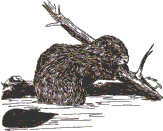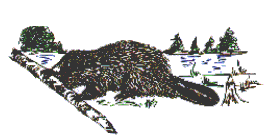The Beaver--Castles As Well
As Dams
 All of us are aware that beavers build dams. Most of us have had the opportunity
to walk on a beaver dam or at least see movies of other people doing it.
As a child, I spent many happy hours fishing and swimming in ponds produced
by beavers. Once as an 8-year-old child, I found a huge beaver lodge. It
was nearly as high above the water as I was and must have measured 25 feet
in diameter. Prodding around the edge of the mud plastered pile of woody
materials, I found one of the several entrances the lodge had, and I tried
crawling up through the tunnel but ran out of breath and nerve before I
could get into the interior. I expected the tunnel to have a rough surface
with a lot of protruding sticks, but I remember the floor of the tunnel
being smooth and free of protruding sticks.
All of us are aware that beavers build dams. Most of us have had the opportunity
to walk on a beaver dam or at least see movies of other people doing it.
As a child, I spent many happy hours fishing and swimming in ponds produced
by beavers. Once as an 8-year-old child, I found a huge beaver lodge. It
was nearly as high above the water as I was and must have measured 25 feet
in diameter. Prodding around the edge of the mud plastered pile of woody
materials, I found one of the several entrances the lodge had, and I tried
crawling up through the tunnel but ran out of breath and nerve before I
could get into the interior. I expected the tunnel to have a rough surface
with a lot of protruding sticks, but I remember the floor of the tunnel
being smooth and free of protruding sticks.
In Natural History, March 1, 2001, page 30, Peter Marchand
tells of being able to go into a lodge where the beavers had left the area
because their dam was destroyed. It turns out that the interior of the
beaver lodge is totally smooth with all nubs of sticks chewed off to make
it a comfortable place to be. Some scientists have had problems with beavers
biting off probe instruments inserted into their lodges. Marchand also
tells of feeding platforms placed to the side out of the water.
 All of this is very interesting, but the adaptations made in the lodge
to address the special problems that beavers have in the winter are truly
amazing. Beavers have a normal body temperature of 98°F. To avoid hypothermia
(excessive loss of body heat) is a real problem. First of all, the air
temperature outside the lodge can be -40°F, but once the lodge is open
to the water of the pond at the bottom of the lodge is always close to
+32°F. Two or three beavers contributing their own body heat to the
water's head will make the lodge as warm as 60°F. With their fur, the
beavers are warm as long as they are in the lodge.
All of this is very interesting, but the adaptations made in the lodge
to address the special problems that beavers have in the winter are truly
amazing. Beavers have a normal body temperature of 98°F. To avoid hypothermia
(excessive loss of body heat) is a real problem. First of all, the air
temperature outside the lodge can be -40°F, but once the lodge is open
to the water of the pond at the bottom of the lodge is always close to
+32°F. Two or three beavers contributing their own body heat to the
water's head will make the lodge as warm as 60°F. With their fur, the
beavers are warm as long as they are in the lodge.
Another problem exists when the beavers enter the water to get
food. Water compresses their fur and removes air bubbles. Water is a good
conductor of heat. All of these together mean that, if a beaver is in the
water more than 30 minutes, hypothermia is a real risk. On top of that,
if all the beavers in the lodge are foraging in the water, the lodge cools
down so there is more of a struggle to regain heat when they return to
the lodge. Recent studies have shown that this problem is solved in a remarkable
way. Unlike most living things, beavers have no fixed activity cycles.
Most living things sleep, eat, exercise, etc., in a regular pattern which
are basically the same for all members of the species. In the wintertime,
members of a beaver lodge will all have different patterns so that there
is never a time when all the beavers are out of the lodge at the same time.
This is vital for kits (young beavers) who do not have enough fat to insulate
them enough to survive the cold well. As it is, when a beaver returns to
the lodge after searching for food, it will return to a heated lodge maintained
by the other members of the lodge.
Mankind has only recently come to realize what the problems faced
by an animal like a beaver are, much less how those problems can be solved.
Only by a planning intelligence can animals like the beaver flourish--even
in a world full of hostile elements.
Back to Contents Does God Exist?, SepOct01.
 All of us are aware that beavers build dams. Most of us have had the opportunity
to walk on a beaver dam or at least see movies of other people doing it.
As a child, I spent many happy hours fishing and swimming in ponds produced
by beavers. Once as an 8-year-old child, I found a huge beaver lodge. It
was nearly as high above the water as I was and must have measured 25 feet
in diameter. Prodding around the edge of the mud plastered pile of woody
materials, I found one of the several entrances the lodge had, and I tried
crawling up through the tunnel but ran out of breath and nerve before I
could get into the interior. I expected the tunnel to have a rough surface
with a lot of protruding sticks, but I remember the floor of the tunnel
being smooth and free of protruding sticks.
All of us are aware that beavers build dams. Most of us have had the opportunity
to walk on a beaver dam or at least see movies of other people doing it.
As a child, I spent many happy hours fishing and swimming in ponds produced
by beavers. Once as an 8-year-old child, I found a huge beaver lodge. It
was nearly as high above the water as I was and must have measured 25 feet
in diameter. Prodding around the edge of the mud plastered pile of woody
materials, I found one of the several entrances the lodge had, and I tried
crawling up through the tunnel but ran out of breath and nerve before I
could get into the interior. I expected the tunnel to have a rough surface
with a lot of protruding sticks, but I remember the floor of the tunnel
being smooth and free of protruding sticks.
 All of this is very interesting, but the adaptations made in the lodge
to address the special problems that beavers have in the winter are truly
amazing. Beavers have a normal body temperature of 98°F. To avoid hypothermia
(excessive loss of body heat) is a real problem. First of all, the air
temperature outside the lodge can be -40°F, but once the lodge is open
to the water of the pond at the bottom of the lodge is always close to
+32°F. Two or three beavers contributing their own body heat to the
water's head will make the lodge as warm as 60°F. With their fur, the
beavers are warm as long as they are in the lodge.
All of this is very interesting, but the adaptations made in the lodge
to address the special problems that beavers have in the winter are truly
amazing. Beavers have a normal body temperature of 98°F. To avoid hypothermia
(excessive loss of body heat) is a real problem. First of all, the air
temperature outside the lodge can be -40°F, but once the lodge is open
to the water of the pond at the bottom of the lodge is always close to
+32°F. Two or three beavers contributing their own body heat to the
water's head will make the lodge as warm as 60°F. With their fur, the
beavers are warm as long as they are in the lodge.